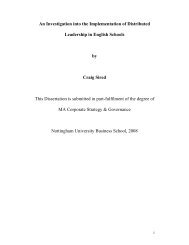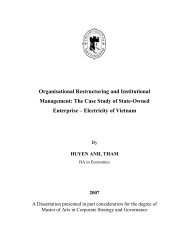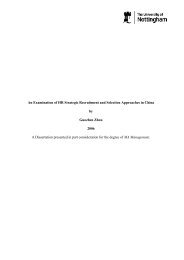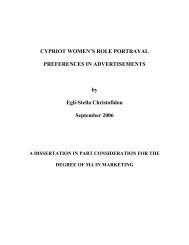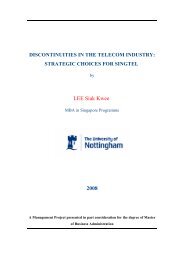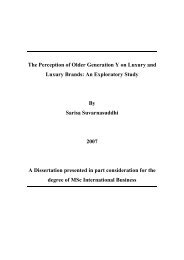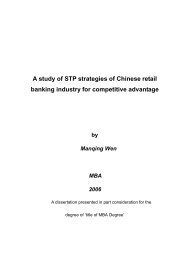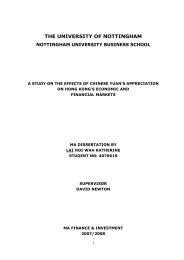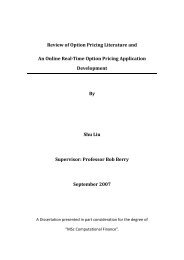application of real options valuation to r&d investments in ...
application of real options valuation to r&d investments in ...
application of real options valuation to r&d investments in ...
You also want an ePaper? Increase the reach of your titles
YUMPU automatically turns print PDFs into web optimized ePapers that Google loves.
delayed <strong>in</strong> time. Undertak<strong>in</strong>g one project may rule out other superior projects anditself at some later data, thus trad<strong>in</strong>g <strong>of</strong>f the <strong>in</strong>stant value by exercis<strong>in</strong>g the project<strong>to</strong>day aga<strong>in</strong>st the opportunity <strong>of</strong> future project ga<strong>in</strong>s.But it does not necessarily mean that <strong>real</strong> <strong>options</strong> <strong>valuation</strong> methods can replace NPVor DCF methods. This is because <strong>to</strong> use <strong>real</strong> option <strong>valuation</strong> methods, the value <strong>of</strong>the underly<strong>in</strong>g asset has <strong>to</strong> be calculated, and DCF is typically used for value that.Moreover, DCF is useful for safe cash flows, where there is less uncerta<strong>in</strong>ty. In all,<strong>real</strong> <strong>options</strong> <strong>valuation</strong> method <strong>of</strong>fers a better way <strong>of</strong> captur<strong>in</strong>g the value <strong>of</strong> flexibility,and DCF method can be viewed as the base model <strong>of</strong> <strong>real</strong> <strong>options</strong> method when thereis no possibility <strong>of</strong> calculat<strong>in</strong>g <strong>of</strong> the value <strong>of</strong> the flexibility <strong>of</strong> the project, argued byNew<strong>to</strong>n, Paxson and Widdicks (2004).2.2.3 Advantages over decision trees methodThe <strong>real</strong> <strong>options</strong> approach <strong>of</strong>fers several advantages over decision trees method.Firstly, although decision trees method is useful for model<strong>in</strong>g the possible outcomesthat associated with uncerta<strong>in</strong> subsequent activities <strong>in</strong> a project and evaluate allalternative actions managers can take, the decision trees method is discrete <strong>in</strong> time(Bode-Greuel, 2000). In contrast, <strong>options</strong> analysis is cont<strong>in</strong>uous.Secondly, decision trees analysis will not give the correct value for <strong>options</strong> because itis not a risk neutral analysis. As <strong>in</strong>dicated by Bode-Greuel (2000), decision treesmethod is a model <strong>of</strong> decision makers‘ <strong>in</strong>dividual attitude <strong>to</strong>ward risk because theymake subjective judgment which is based on the characteristics <strong>of</strong> utility function.Although the expected PV <strong>of</strong> a project is computed by assum<strong>in</strong>g that decision makeris risk-neutral <strong>in</strong> decision trees analysis, probability is determ<strong>in</strong>ed by the <strong>in</strong>formationavailable at the time when decision maker do<strong>in</strong>g analysis. This implies that thedecision makers are analyz<strong>in</strong>g projects <strong>in</strong> accordance with their risk attitudes, i.e. thedegree <strong>of</strong> risk-seek<strong>in</strong>g or risk-averse. Conversely, <strong>real</strong> <strong>options</strong> analysis assumes arisk-neutral world, where probability assessment is not depended on decision makers‘Page | 15



